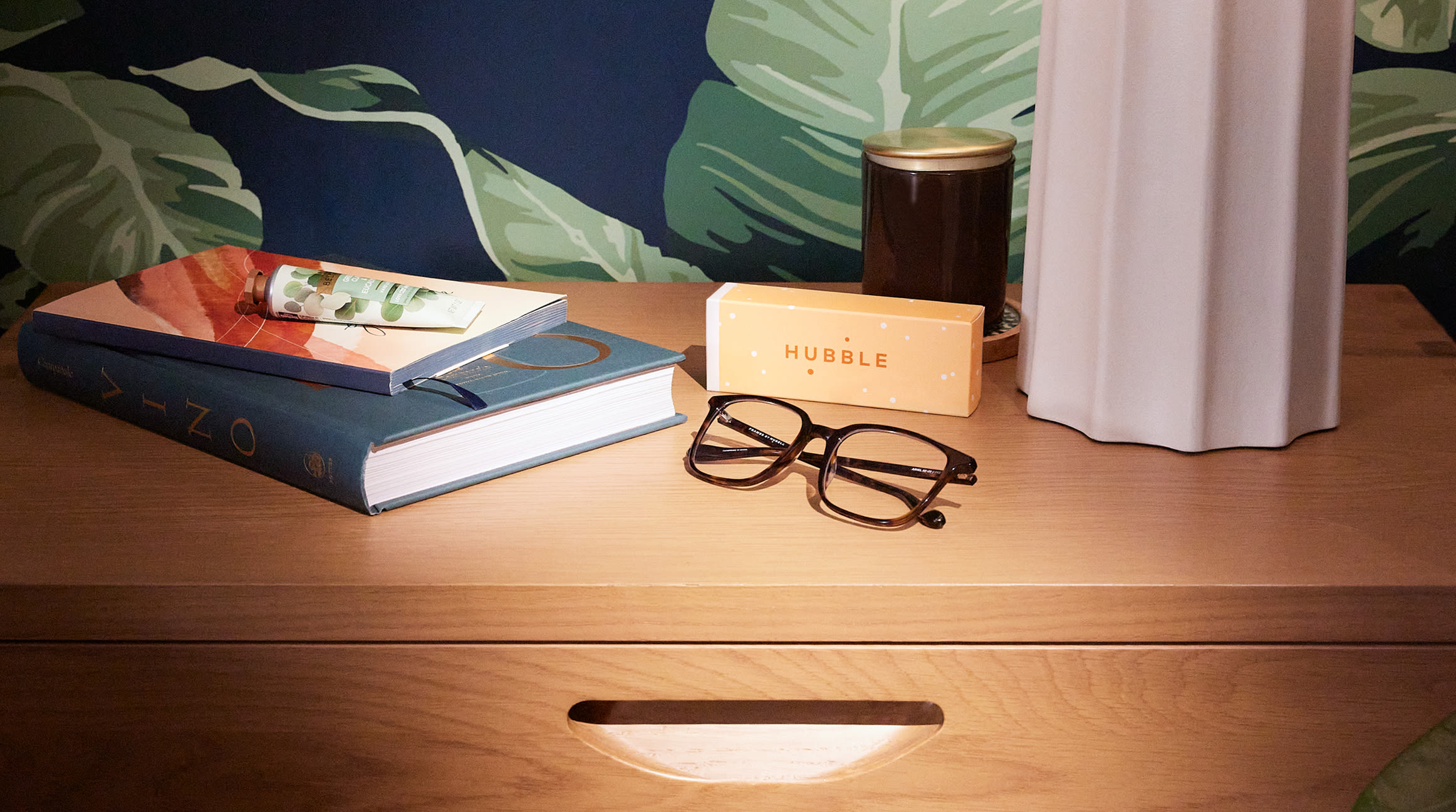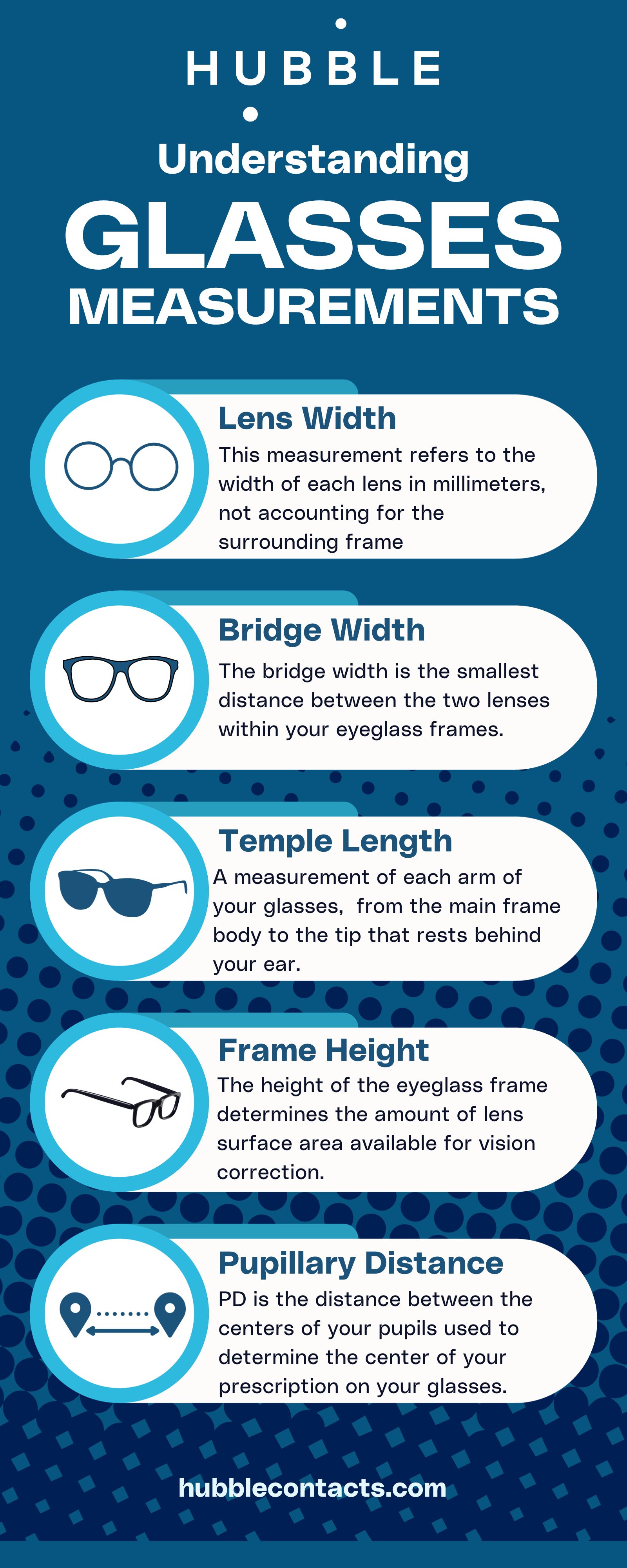Glasses Measurements: How to Find Your Perfect Fit Frames

Glasses Measurements: How to Find Your Perfect Fit Frames
Finding glasses that fit well is essential for both comfort and style. Understanding your ideal glasses size and the significance of various glasses measurements, such as lens width, bridge width, temple length, and frame height are important parts of determining the best pair for you.
This guide will help you learn how to measure these dimensions accurately, either at home or with the assistance of an optician. Additionally, we'll address common fitting issues and suggest frame styles that compliment different face shapes. Discover the art of finding glasses that not only feel great but also enhance your unique personality and style.
Understanding Glasses Measurements
Understanding eyeglasses measurements is crucial for achieving the best possible vision correction, comfort, and overall satisfaction with your eyewear. It allows you to make informed choices when selecting frames and lenses and helps ensure your eyeglasses serve their purpose effectively.

Lens Width
The lens width is a critical measurement when determining the right fit for your eyeglasses. It plays a significant role in both the aesthetics and functionality of your eyewear.
Measuring your eyeglass width is essential to ensure you select frames that fit your face properly. measure the eyeglass width, follow these steps:
Tools you'll need:
A millimeter ruler or a tape measure
A mirror
Step-by-step guide:
Find a well-lit area and stand in front of a mirror. Ensure that your face is relaxed and your hair is not obstructing your ears or the sides of your face.
Take the millimeter ruler or tape measure and hold it horizontally, positioning it just above your eyebrows. Ensure that the ruler is straight and level.
Starting from the outer edge of one temple (the side of your face near your ears), measure horizontally across the front of your face to the outer edge of the opposite temple. The temples are the arms of your glasses that extend backward from the frame.
Carefully read the measurement in millimeters. This measurement is your eyeglass width or frame width.
Note the measurement. You may want to measure a few times to ensure accuracy, as even a slight difference can affect the fit of your glasses.
If you already have a pair of eyeglasses that fit well, you can also check the width measurement on the inside of the temple arm. Many eyeglasses have this measurement printed as "frame width" or "eye size." This measurement can also serve as a reference for choosing frames of a similar width.
Bridge Width
Measuring the bridge width of your eyeglasses with precision is important for ensuring comfort and stability, as it helps you choose frames that fit your face properly. Here's how you can measure eyeglass bridge width accurately:
If you already have a pair of glasses with a comfortable bridge width, you can use them as a reference. Remove your glasses to start measuring.
Place your glasses on a flat surface with the lenses facing up. Ensure that the temples (the arms of the glasses) are fully extended to their natural position, not bent or twisted.
Identify the bridge - the bridge is the part of the glasses that sits across your nose. It's the small piece that connects the two lenses.
Make sure your ruler is placed parallel to the top edge of the lenses, following the natural curve of the bridge.
Ensure your measurement is in millimeters for accuracy. Most eyeglasses are measured in millimeters.
Write down the bridge width measurement in millimeters. You may want to measure it a few times to ensure accuracy.
Temple Length
The temple length determines how the glasses wrap around your head. If the temples are too short, they may pinch or feel tight behind your ears. If they are too long, they may slip down your nose. Finding the right temple length ensures a comfortable fit. Proper temple length is essential for eyeglasses to securely rest behind your ears without causing discomfort or pressure points.
Steps to Measure Temple Length:
Lay your eyeglasses on a flat surface with the temples (the arms of the glasses) fully extended and lying flat. Ensure that the glasses are positioned as they would be when worn.
Identify the temples of your eyeglasses. These are the long, straight arms that extend from the frame and go over your ears.
Measure from Hinge to Tip: using your ruler or measuring tape, measure from the hinge (the point where the temple attaches to the frame) to the tip of the temple. The hinge is typically located near the front of the frame.
Write down the temple length measurement. Ensure that your measurement is in millimeters for accuracy. You may want to measure it a few times to ensure precision.
Frame Height
The height of the eyeglass frame determines the amount of lens surface area available for vision correction. Frame height influences your field of vision. A taller frame may limit your vertical peripheral vision slightly compared to a shorter frame. For some people, this can be a factor to consider, especially if they engage in activities where a wide field of view is crucial.
Steps to Measure Eyeglasses Frame Height:
Begin by placing your eyeglasses on a flat, well-lit surface.
Ensure that your eyeglasses are oriented correctly. The front of the glasses, including the lenses, should be facing up.
Locate the top and bottom edges of the eyeglass frame. The top edge is where the lenses meet the frame, and the bottom edge is the lowermost part of the frame.
Measure the Height - Using your ruler or measuring tape, measure the vertical distance from the top edge of the frame to the bottom edge. Make sure your measurement is in millimeters for accuracy.
Keep the ruler or measuring tape parallel to the frame, running vertically along one of the temple arms. This ensures an accurate measurement.
Write down the frame height measurement. It may be helpful to take this measurement a few times to ensure precision.
Tips for Measuring Your Perfect Fit
Remember that the ideal frame width may vary based on your face shape, so it's a good idea to consult with an optometrist or optician when selecting new eyeglasses to find the right glasses size and style that suits your face and prescription needs.
A quick solution to finding your accurate fit is using a pair of existing glasses that you already own that fits you perfectly without issue. You can locate the numerical representation of your eyeglasses measurements found inscribed on the arms of your glasses.
Keep in mind that eyeglasses measurements are typically written in a format like "XX-YY-ZZ," where:
XX represents the lens width (the horizontal measurement of one lens).
YY represents the bridge width (the distance between the lenses at the nose).
- >
ZZ represents the temple length (the length of the arms extending to the ears).
Many eyeglasses have this measurement printed as "frame width" or "eye size."
DIY Measurements
PD (measured in millimeters) is the distance between the centers of your pupils. Your specific PD is used to determine the center of your prescription on your glasses, so an accurate measurement is needed to determine proper vision correction. If your PD is incorrect, your vision may be affected—resulting in potential eye strain, fatigue, headaches, and blurry vision.
Measuring your Pupillary Distance (the distance between your pupils) is a common at home DIY measurement that you can use. If doing this at-home, you can either download a dedicated app or take advantage of either of these two common methods:
Stand in front of a mirror and hold the ruler horizontally. Align the '0' mark with the center of one pupil while looking straight ahead. Have someone else measure the distance from the center of one pupil to the center of the other pupil. Repeat this measurement a few times and take the average.
Use a printed PD measurement tool or draw two dots on a sheet of paper, about the same distance apart as your pupils. Hold the paper up to your face with one dot in front of each eye, and have someone measure the distance between the dots.
Remember that while these DIY measurements can provide a rough idea of your eyeglasses requirements, they may not consider all aspects of your face shape or specific prescription needs. For the best results, consult with an eye care professional for a comprehensive eyeglasses fitting.
Should You Measure Eyeglasses Yourself or Visit Your Eye Doctor?
Eyeglasses measurements can be done independently at home with a ruler, but visiting a doctor is the best way to guarantee a perfect fit. A doctor’s visit is also required to obtain a new glasses or contact lenses prescription.
While at-home measurements can help you get an idea of your eyeglasses’ dimensions, they may not account for all factors that affect fit, such as face shape and specific prescription requirements. For a more accurate fitting, especially for complex prescriptions or unique frame styles, consult with an optometrist or optician.
Frame Styles for Different Face Shapes
Different eyeglass frames can complement various face shapes. For example, individuals with smaller faces may look better with narrower lenses, while those with larger faces may opt for wider lenses. Choosing the right lens width can enhance your facial proportions. When buying prescription eyeglasses online, you will make your selection based on the frame shape and eyeglasses size. With Hubble, you can shop by frame shape or face shape to browse a selection of styles unique to your needs!
Explore Frames by Hubble
By following the guidance in this article, you can find eyeglasses and eye care accessories that fit perfectly and enhance your comfort and style. Understanding eyeglasses measurements is a crucial step in selecting the ideal frames for your unique needs. Whether you choose to measure at home or seek assistance from an optician, finding your perfect fit is key to enjoying eyeglasses that look great and feel even better.
For more eyewear inspiration and guidance, explore our related articles on measuring your PD, finding glasses based on your face shape, and explore the stylish Frames by Hubble collection.
With Hubble, you can find high-quality and affordable prescription eyeglasses and sunglasses. Once you decide on your new glasses, you'll enter your prescription and select your preferred lens type. After that, we’ll take care of the rest, customizing your glasses to your specifications and shipping them directly to your door!



